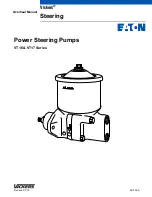
22
Safety Instructions for Oscillating Edge Belt/Spindle Sander
Before Using The Sander
WARNING: To reduce the risk of
mistakes that could cause seri-
ous, permanent injury, do not
plug the sander in until the fol-
lowing steps are completed.
• Assembly. (See pages 12-19)
• Learn the use and function of the
ON-OFF switch. (See page 21)
• Review and understanding of all
safety instructions and operating
procedures in this manual.
• Review of the maintenance meth-
ods for this sander. (See page 29)
When Installing Or Moving The Sander
Avoid dangerous environment.
Use the sander in a dry, indoor place
protected from rain. Keep work area
well lighted.
To reduce the risk of burns or other
fire damage, never use the sander
near flammable liquids, vapors or
gasses.
To reduce the risk of injury or
death from electrical shock:
• Ground the sander. This sander has
an approved 3-conductor cord and a
3-prong grounding type plug. Use
only 3-wire, grounded outlets rated
120 volts, 15 amperes (amps). The
green conductor in the cord is the
grounding wire. To reduce the risk of
electrocution, Never connect the
green wire to a live terminal.
• Make sure your fingers do not touch
the plug’s metal prongs when plug-
ging or unplugging the sander.
• Never use this or any power sander
for wet sanding. Doing so could
cause electrocution, serious injury
or worse.
To reduce the risk of injury from
unexpected sander movement:
• Always unplug the sander before
moving it.
• Put the sander on a firm level sur-
face where there is plenty of room
for handling and properly supporting
the workpiece.
• Attach rubber feet.
• Support the sander so it does not
rock.
• Bolt the sander to its work surface.
Use the fasteners and method
shown in “Assembly.” (page 16)
• Never stand on tool. Serious injury
could occur if the tool tips. Do not
store anything above or near the
tool where anyone might stand on
the tool to reach them.
Before Each Use
Inspect your sander. Check for:
• alignment of moving parts,
• binding of moving parts,
• broken or damaged parts,
• work parts that cause a gap larger
than 1/16" between work support
and sanding surface,
• sanding belt narrower than 4 inches.
Narrower belts uncover parts that
could trap your fingers,
• worn or damaged electric cords,
• stable mounting, and
• any other conditions that may affect
the way the sander works.
• Remove adjusting keys and
wrenches. Form a habit of checking
for and removing keys and adjusting
wrenches from table top before turn-
ing sander on.
Содержание EB4424
Страница 1: ...OSCILLATING EDGE BELT SPINDLE SANDER ...
Страница 35: ...35 Notes ...















































